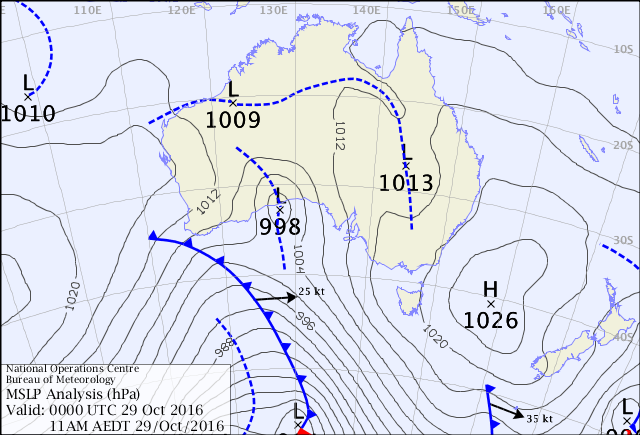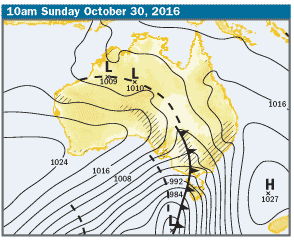Date: 29/10/2016
Flight Time: 1.0
Aircraft: VH-KEP
Airport: Hervey Bay Aerodrome
Instructor: MM , Briefing time (hr): 0
Time to take off: 08:30 Runway: 11
Time to land: 9:30 Runway: 11 Total Engine time: 1.0 Approx. Fuel 36 L
Wx at aerodrome: Temp 26 Cloud Clear below 1200 ft, Wind Direction 060 deg, Wind Strength 8 kts , Dewpoint 14, Rainfall nil, Wind types __, Visibility 10 km, Humidity 46%, QNH 1019, Changes in Wx Conditions, BOM daily wx obs: Temps Min (°C) 14.9, Max (°C) __, Rain (mm) 0, Evap __, Sun __, [[Max daily wind gust: Dir __, Spd (km/h) __, Time (local) __]] [[9:00am record: Temp (°C) 25.5, RH (%) 52, Cloud __, Dir ENE, Spd (km/h) 13, MSLP (hPA) 1019.0]], [[3:00pm record: Temp (°C) __, RH (%) __, Cloud __ , Dir __, Spd (km/h) __, MSLP (hPa) __]]
http://www.bom.gov.au/climate/dwo/IDCJDW4056.latest.shtml
TAF YHBA 282132Z 2900/2912
04012KT 9999 FEW040
FM290900 07007KT 9999 SCT030
RMK
T 26 27 25 22 Q 1018 1017 1016 1018
METAR YHBA 290230Z AUTO 04007KT 360V090 9999 // NCD 26/14 Q1017
RMK RF00.0/000.0


Goals: Review previous lesson and optimise operation of aircraft… Downwind checks, operating minimums (1/2 balance ball, +10/10 heading, Vref +5 kts -0 kts, +150 ft of set altitudes, main wheels first), maintain consistent tracking, pre-landing checklist, emergency engine cut off routine practice ++ Exams: Apply revision of all aviation theory to date + Radio license and operation checks.
Briefing discussion: Home-study on circuits, own notes – exam preparation. No formal briefing necessary as one was due to practice the circuit pattern and improve on skills.
Tasks: pre-flight checks, oil and fuel check, wheel chocks, start-up procedures and checks, radios, take-off, climbing, descent, turns, preflight briefing (re-aborted take-off procedure), touch’n’go x1, x2 missed approach & go-arounds + 1 demonstrated emergency engine cut out + 3 practice engine cut-off landings final landing.
Notes: 110 L of fuel on take-off. Runway 11 makes for an interesting take-off given the dip in the runway at mid-point. This was overall a challenging lesson learning and applying new skills to the basic circuit pattern. Initial circuit was terrible however and had a very steep approach on landing, but recovered nicely.
The missed approaches were executed at 200 ft of the ground on approach. Basic procedure involved; full power, attitude adjustment, full mixture, fuel pump on and progressive raising of flaps (careful attention to airspeed, climb rate and attitude) while climbing out. Make radio-call to signify go-around as required. This was fluid by the second attempt.
By far the most interesting part of the lesson was when I was shown how to land with an engine-out on mid-downwind. Key points learned; make an immediate turn towards the runway with holding nose attitude setting the glide speed. Aim initially at a point 2/3rds down the runway closest to where you are approaching. Maintain glide-speed and put flaps down only when you feel you could make the field.
On initial practice it was evident I did not make enough of an effort to get to glide-speed early on… instructor aborted by applying thrust as we were entering the aerodrome with a shallow and oblique approach.
Second attempt made with a right-handed circuit (to avoid local skydiver group). Made an easy glide back to base and entered a third circuit to the left shortly after. Due to the novelty of working on the right-circuit, instructor took over making clear radio calls.
Final engine-failure practice was for a full-stop that was actually quite smooth and overall quite well done.
Radio chatter was quite interesting with the RFDS landing within the hour, several direct approaches from 8-9 nm, a sky-diving troupe (coordinated carefully in terms of timing) and a congested pattern to manage on the second missed approach practice. I kept ahead of the traffic calls and answered questions directly in communication with other aircraft. Again I was able to record this but my SDR radio doesn’t capture other radios that well for some reason (probably because of the poor tuning characteristics)…
https://clyp.it/zozetssj/widget
The Exam for Radio calls and Pre-flight solo were more challenging than I anticipated… but I still did great (93% for both tests) some of what featured on the test (from memory)
Readability codes (RST):
- Unreadable
- Barely readable, occasional words distinguishable
- Readable with considerable difficulty
- Readable with practically no difficulty
- Perfectly readable
Mayday call code… (NAANIPPA)
- MAYDAY, MAYDAY, MAYDAY (yes, three times)
- Name of station addressed
- Aircraft call sign
- Aircraft type
- Nature of emergency
- Intentions of pilot
- Position (or last known position): flight level/Altitude/Height; heading
- Pilot Qualifications (No instrument qualifications: IMCrating etc.)
- Any other useful information e.g. persons on board etc.NB: The same things can be mentioned for PAN PAN PAN calls… Remember the ultimate difference between a Mayday and a Pan is that one is a distress call the other is an urgent situation.
Distress: The aircraft is threatened by serious and/or imminent danger and requires immediate assistance
Urgency: A condition concerning the safety of an aircraft or other vehicle, or of some person on board or in sight, but not requiring immediate attention
Engine fire protocol:
– set glide attitude, pick field and flaps as necessary
– try to cease fire by leaning mixture, fuel pump off, throttle off, carb heat on
– radio calls
– use fire hydrant as necessary
– land safely/brace for impact
Minimum time from last alcoholic drink to flight is 8 hrs.
Apparently smoking is allowed while flying – as crazy as that sounds there is no total ban on smoking… it’s just not allowed when the pilot is attempting to land/take off, or while refuelling.
Transponder ‘squark code’ settings:
– 1200 for VFR, 1202 for gliders, 3000 for controlled airspace, 7500 for hijack ’7, 5 taken alive’, 7600 communications failure ’7, 6 radio fix’, 7700 Emergency ‘7,7 going to heaven’
NDB beacons are transmitted on low frequency and middle frequency ranges…
Ground waves vs Air waves – state the differences;
Propagation distances <5,000 ft ~60 nm, ~10,000 ft ~90 nm
ERSA contains information about airfield specific radio failure procedures
Specific aircraft knowledge; speeds; VFE (101), FNE (152), VNO (112), Va (124), Vx (64), Vy (76), Vs (w (51)/wo flaps (59)), normal climb (80), glide (70) short field (65), approach w/flaps (65-70), w/oflaps (75-80).
Fuel capacity (188 L) type of fuel (100LL), type of oil ? (6-8 quarts), total output (180 BHP at 2300 RPM), total weight w/fuel and oil 686, max capacity 1111 kg, 4 cylander carburettor engine.
Radios: YHBA AWIS 134.9 MHz, general CTAF 126.55 MHz